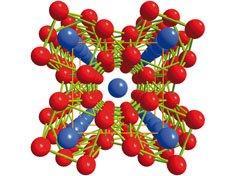
Submitted by Prof. C.J. Pickard on Wed, 12/10/2016 - 17:14
Under normal conditions matter is mostly empty space. Atoms are built from a dense nucleus of protons and neutrons, with the void between filled by a comparably tenuous cloud of electrons shuttling about, following quantum mechanical rules. High pressure physicists squeeze hard on this empty space (using mechanical presses, diamond anvils, or shock waves from sudden impacts or laser light), forcing the electrons to occupy smaller volumes.
The incredibly small distances between particles in the collisions generated by the Large Hadron Collider (LHC) to simulate the compressed universe shortly after the big bang can be thought of as the extreme limit of high pressure physics. But there is a vast gap in our knowledge of the behaviour of dense matter laying between high energy particle physics and the rather modest pressures generated routinely in the laboratory. A new generation of laser shock experiments, to be performed using machines such as the National Ignition Facility (NIF) in the United States, is set to change this - and while no one knows what they will find, it had been generally assumed that the atoms would be rather boringly well (or close) packed.
In 2006 Chris Pickard and Richard Needs (Cambridge) introduced a simple and effective method for the prediction of material structure at high pressure. Their method, dubbed "ab initio random structure searching" (AIRSS) combines quantum mechanics with trying many random configurations for the starting positions of the atoms. Confidence has grown in the method, following impressive "blind" (not depending on any experimental observations) predictions of unexpected materials, which have subsequently been found to exist in diamond anvil cell experiments.
Encouraged, Pickard and Needs have started to explore the behaviour of matter at extremely high pressures - those to be explored by the laser shock experiments at the NIF, and encountered in the centres of the recently discovered large exoplanets, and gas giants of our own solar system. They have found (published in Nature Materials) that far from being boring, even such a standard and elemental material such as aluminium adopts intriguing complex structures (pictured) at pressures ten times those found in the centre of the earth. They track down the origin of these mysterious atomic arrangements to the squeezing of electrons from the atoms to the gaps between them, forming what is known as an 'electride' - or an ionic structure in which the anions are electrons alone.
The full article features in Nature Materials, accompanied by a News and Views by Malcolm McMahon and Graeme Ackland, and in this month's PsiK newsletter.

